Solved Examples and Worksheet for Linear Programming Problems
A. C = 45 +
B. C = 19
C. C = 494
D. C = 26
Step: 1
The cost of each tape is $19 and the cost of each CD is $26.
Step: 2
The cost C of c x c x
Correct Answer is : C = 19c x
A. 2 of A, 4 of B
B. 4 of A, 1 of B
C. 1 of A, 4 of B
D. 4 of A, 2 of B
Step: 1
Let the number of units of models A and B to be made per day be x y
Step: 2
The objective function is P = 400x y
[The manufacturer wants to maximize the profit P.]
Step: 3
To make x y x y x y
Step: 4
To make x y x y x y x y
Step: 5
[As x y
Step: 6
The feasible region determined by the above constraints is shown.
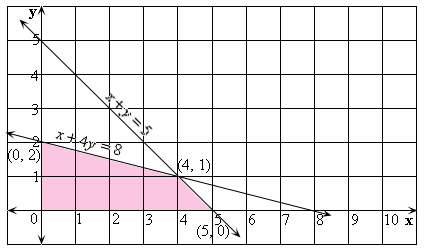

Step: 7
From the figure the vertices are (0, 0),(5, 0), (4, 1), (0, 2).
Step: 8
At (0, 0), P= 400(0) + 480(0) = 0
[Substitute the values.]
Step: 9
At (5, 0), P = 400(5) + 80(0) = 2000
[Substitute the values.]
Step: 10
At (4, 1), P = 400(4) + 480(1) = 2080
[Substitute the values.]
Step: 11
At (0, 2), P = 400(0) + 480(2) = 960
[Substitute the values.]
Step: 12
So, the maximum profit can be obtained by making 4 units of model A and 1 unit of model B.
Correct Answer is : 4 of A, 1 of B
A. 36 toys of A, 18 toys of B
B. 80 toys of A, 70 toys of B
C. 45 toys of A, 30 toys of B
D. 60 toys of A, 10 toys of B
Step: 1
Let the number of toys A and B to be made be x y
Step: 2
The objective function is the profit P = 70x y
Step: 3
To make x y x y 1 1 2 x y
[ 1 1 2
Step: 4
To make x y x y y 1 1 2 x y
[1 1 2
Step: 5
[x y
Step: 6
The feasible region determined by the above constraints is shown.
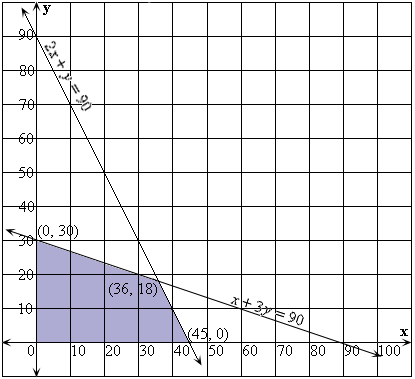

Step: 7
From the figure the vertices are (0, 0), (45, 0), (36, 18) and (0, 30).
Step: 8
At (0, 0), P = 70(0) + 60(0) = 0.
[Substitute the values.]
Step: 9
At (45, 0), P = 70(45) + 60(0) = 3150.
[Substitute the values.]
Step: 10
At (36, 18), P = 70(36) + 60(18) = 3600.
[Substitute the values.]
Step: 11
At (0, 30), P = 70(0) + 60(30) = 1800.
[Substitute the values.]
Step: 12
So, the maximum profit can be obtained by making 36 toys of A and 18 toys of B.
Correct Answer is : 36 toys of A, 18 toys of B
A. 450 tables, 150 chairs
B. 450 tables, 300 chairs
C. 300 tables, 150 chairs
D. 450 tables, 200 chairs
Step: 1
Let the number of tables and chairs to be purchased be x y
Step: 2
P = 14x y
[Objective function is profit, P, profit for a table is $14 and a chair is $10.]
Step: 3
The dealer can invest $60,000 we have 120x y x y
[Cost of table is $120, cost of chair is $40.]
Step: 4
[The storage capacity is for 600 pieces.]
Step: 5
[x y
Step: 6
The feasible region determined by the above constraints is shown.
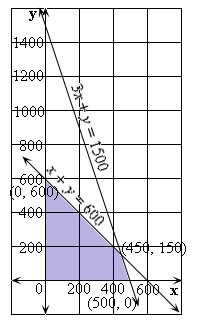

Step: 7
From the graph the vertices are (0, 0), (500, 0), (450, 150) and (0, 600)
Step: 8
At (0, 0), P = 14(0) + 10(0) = 0
[Substitute the values.]
Step: 9
At (500, 0), P = 14(500) + 10(0) = 7000
[Substitute the values.]
Step: 10
At (450, 150), P = 14(450) + 10(150) = 7800
[Substitute the values.]
Step: 11
At (0, 600), P = 14(0) + 10(600) = 6000
[Substitute the values.]
Step: 12
So, the maximum profit can be obtained by purchasing 450 tables and 150 chairs.
Correct Answer is : 450 tables, 150 chairs
A.
B.
C.
D.
Step: 1
Step: 2
The maximum number of blackberries that can be bought is 20. So, a
Step: 3
The maximum number of apricots that can be bought is 19. So, c
Step: 4
The minimum number of blackberries to be bought is 17. So, a
Step: 5
The minimum number of apricots to be bought is 14. So, c
Step: 6
So, the system of inequalities that models the given situation is:
a c a c
Correct Answer is : a c a c
A. 7 model B cabinets only
B. 12 model A cabinets only
C. 4 model A and 5 model B cabinets
D. 8 model A and 3 model B cabinets
Step: 1
Let x y
Step: 2
Paul's objective is to maximize the storage volume, that is maximize the function V(x y x y
[Cabinet A holds 4 cubic feet of files and Cabinet B holds 6 cubic feet of files.]
Step: 3
Cabinet A costs $5 per unit and cabinet B costs $10 per unit. The amount given for the purchase is $70.
Step: 4
So, 5x y
[Inequality for cabinet costs.]
Step: 5
Floor space required for cabinet A is 3 square feet and that of Cabinet B is 4 square feet. The office has room for at most 36 square feet of cabinets.
Step: 6
So, 3x y
[Inequality for floor space of cabinets.]
Step: 7
[Number of cabinets cannot be negative.]
Step: 8
Let's graph the two inequalities on the same coordinate plane to identify the feasible region. By substituting x = 0 and y = 0 individually in the corresponding equations of the inequalities, we get two points(solutions) for each of the equations using which we can draw the graphs.
Step: 9
The solution set of 5x y
Step: 10
The solution set of 3x y
Step: 11
The feasible region determined by the above constraints is as shown.
Step: 12
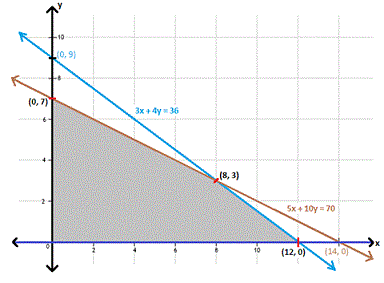
Step: 13
From the figure, the vertices (corner points) of the feasible region are (0, 7), (8, 3) and (12, 0).
Step: 14
Calculate the value of the volume function at each of these vertices to determine which of them has the maximum value. The vertex, at which the value of the volume function is maximized, will be the required solution.
Step: 15
At (0,7), V= 4(0) + 6(7) = 42
[Substitute x y x y
Step: 16
At (8, 3), V= 4(8) + 6(3) = 50
[Substitute x y x y
Step: 17
At (12,0), V = 4(12) + 6(0) = 48
[Substitute x y x y
Step: 18
Therefore, the maximum storage volume is 50 cubic feet. This is achieved by buying eight model A and three model B cabinets.
Correct Answer is : 8 model A and 3 model B cabinets
A. Two ounces of food A and one ounce of food B
B. One ounce of food A and two ounces of food B
C. Four ounces of food A only
D. Three ounces of food A only
Step: 1
Let x
Step: 2
The objective of the lab technician is to minimize the total cost for the daily diet of rabbits, that is minimize the function C(x y x y
[Food A costs $1 per ounce and food B costs $ 1.50 per ounce.]
Step: 3
Food A contains 4 g of fat and food B contains 6 g of fat. In daily diet, the minimum quantity of fat required is 12 g.
Step: 4
So, 4x y
[Inequality for quantity of fat.]
Step: 5
Both food A and food B contain 6 g of carbohydrates each. In daily diet, the minimum quantity of carbohydrates required is 18 g.
Step: 6
So, 6x y
[Inequality for quantity of carbohydrates.]
Step: 7
Food A contains 4g of protein and food B contains 2 g of protein. In daily diet, the minimum quantity of protein required is 8 g.
Step: 8
So 4x y
[Inequality for quantity of protein.]
Step: 9
The maximum weight of the food is five ounces.
Step: 10
So, x y
[In equality for quantity of food.]
Step: 11
[Quantity of food cannot be negative.]
Step: 12
Let's graph the four inequalities on the same coordinate plane to identify the feasible region. By substituting x y
Step: 13
The solution of 4x y
Step: 14
The solution set of 6x y
Step: 15
The solution set of 4x y
Step: 16
The solution set of x y
Step: 17
The feasible region determined by the above constraints is as shown.
Step: 18
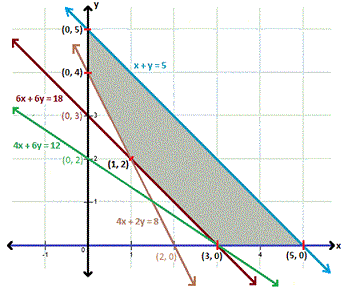
Step: 19
From the figure, the vertices (corner points) of the feasible region are (0,5), (0,4), (1, 2), (3, 0) and (5, 0).
Step: 20
Calculate the value of the cost function at each of these vertices to determine which of them has the minimum value. The vertex, at which the value of the cost function is minimum, will be the required solution.
Step: 21
At (0 ,5) , C = 0 + 1.5(5) = $ 7.50
[Substitute x y x y
Step: 22
At(0,4), C = 0 + 1.5(4) = $6.00
[Substitute x y x y
Step: 23
At (1,2), C = 1 + 1.5(2) = $4.00
[Substitute x y x y
Step: 24
At (3, 0) , C= 3 + 1.5(0) = $3.00
[Substitute x y x y
Step: 25
At (5,0), C = 5 + 1.5(0) = $ 5.00
[Substitute x y x y
Step: 26
Therefore, the minimum cost per daily serving is three dollars. This is achieved using three ounces of food A only.
Correct Answer is : Three ounces of food A only
A. 30
B. 20
C. 15
D. 25
Step: 1
Let x y
Step: 2
The objective of the airlines is to maximize the profit, that is maximize the function P(x y x y
[Profits on selling each business class and economy class tickets are $50 and $30 respectively.]
Step: 3
[At least 10 business class and 15 economy class tickets must be sold to charter the plane.]
Step: 4
[The plane can carry at most 40 passengers.]
Step: 5
Let's graph this inequality on the coordinate plane to identify the feasible region. By substituting x y
Step: 6
The solution set of x y
Step: 7
The feasible region determined by the above constraints is as shown.
Step: 8
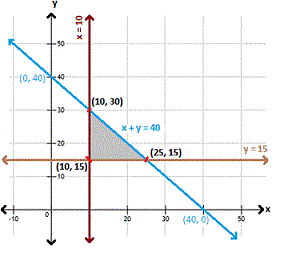
Step: 9
From the figure, the vertices (corner points) of the feasible region are (10, 15), (25, 15) and (10, 30).
Step: 10
Calculate the value of the profit function at each of these vertices to determine which of them has the maximum value. The vertex, at which the value of the profit function is maximum, will be the required solution
Step: 11
At (10, 15), P = 50(10) + 30(15) = $950
[Substitute x y x y
Step: 12
At (25 , 15), P = 50(25) + 30(15) = $1,700
[Substitute x y x y
Step: 13
At (10, 30), P = 50(10) + 30(30) = $1,400
[Substitute x y x y
Step: 14
Therefore, 25 business class seats should be sold to maximize profits.
Correct Answer is : 25
A. 15 units of food X and 2.5 units of food Y
B. 20 units of food X only
C. 25 units of food Y only
D. 10 units of food X and 8 units of food Y
Step: 1
Let x x y y
Step: 2
Here, the objective is to minimize the total cost, that is minimize the function
C(x y x y
[Food X Y
Step: 3
One unit of food X Y
Step: 4
So, 4x y
[Inequality for quantity of vitamin C.]
Step: 5
One unit of food X Y
Step: 6
So, 6x y
[Inequality for quantity of vitamin D.]
Step: 7
[Quantity of food cannot be negative.]
Step: 8
Let's graph the two inequalities on the same coordinate plane to identify the feasible region. By substituting x y
Step: 9
The solution set of 4x y
Step: 10
The solution set of 6x y
Step: 11
The feasible region determined by the above constraints is as shown.
Step: 12

Step: 13
From the figure, the vertices(corner points) of the feasible region are (0,25) , (15,2.5), and (20,0).
Step: 14
Calculate the value of the cost function at each of these vertices to determine which of them has the minimum value. The vertex, at which the value of the cost function is minimum, will be the required solution.
Step: 15
At (0,25), C = 0 + 1.5(25) = $37.50
[Substitute x y x y
Step: 16
At (15, 2.5), C = 15 +1.5(2.5) = $18.75
[Substitute x y x y
Step: 17
At (20, 0), C = 20 + 1.5(0) = $ 20
[Substitute x y x y
Step: 18
Therefore, the minimum cost that meets the daily minimum requirement of vitamin C and D is $18.75. This is achieved using 15 units of food X and 2.5 units of food Y.
Correct Answer is : 15 units of food X and 2.5 units of food Y
A. 120 type Y products only
B. 80 type X products and 120 type Y products
C. 60 type X products and 60 type Y products
D. 100 type X products and 40 type Y products
Step: 1
Let x represent the number of products of type X and y represent the number of products of type Y.
Step: 2
The objective of the company is to maximize the profit, that is maximize the function
P(x y x y
[Profit on type X Y
Step: 3
Machine P takes 3 minutes time on type X product and 3 minutes time on type Y
Step: 4
So, 3x y x y
[Inequality for working hours on machine P.]
Step: 5
Machine Q takes 6 minutes time on type X product and 3 minutes time on type Y product and also given that it is available for at most 10 hours (i.e., 600 minutes) during a working day.
Step: 6
So, 6x y x y
[Inequality for working hours on machine Q.]
Step: 7
[Number of products cannot be negative.]
Step: 8
Let's graph the two inequalities on the same coordinate plane to identify the feasible region. By substituting x y
Step: 9
The solution set of x y
Step: 10
The solution set of 2x y
Step: 11
The feasible region determined by the above constraints is as shown.


Step: 12
From the figure, the vertices (corner points) of the feasible region are (0, 120), (80, 40) and (100, 0).
Step: 13
Calculate the value of the profit function at each of these vertices to determine which of them has the maximum value. The vertex, at which the value of the profit function is maximum, will be the required solution.
Step: 14
At (0, 120), P
[Substitute x y x, y
Step: 15
At (80, 40), P
[Substitute x y x, y
Step: 16
At (100, 0), P
[Substitute x = 100, y P(x, y
Step: 17
Therefore, the maximum profit is $960. This is achieved by manufacturing 120 type Y
Correct Answer is : 120 type Y products only
- Writing Linear Equations-Algebra1-Solved Examples
- Writing Linear Equations using Rate of Change for a Situation or a Table-Algebra1-Solved Examples
- Solving Equations for a Specified variable-Algebra1-Solved Examples
- Solving Linear Equations - Word Problems-Algebra1-Solved Examples
- Create Equations and Inequalities to Solve Problems-Algebra1-Solved Examples
- Fitting Exponential Models to Data-Algebra1-Solved Examples
- Writing and Solving Systems of Linear Equations-Algebra1-Solved Examples
- Application of Quadratic Equations-Algebra1-Solved Examples
- Exponential Growth and Decay-Algebra1-Solved Examples
Related Worksheet
- Linear Programming